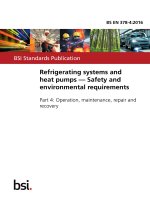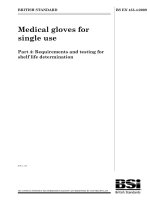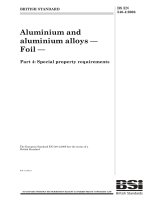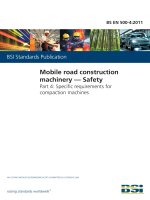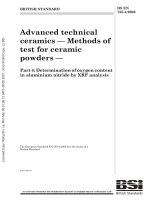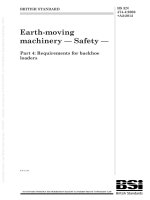Bsi bs en 61340 4 9 2016
Bạn đang xem bản rút gọn của tài liệu. Xem và tải ngay bản đầy đủ của tài liệu tại đây (4.67 MB, 30 trang )
BS EN 61340-4-9:2016
BSI Standards Publication
Electrostatics
Part 4-9: Standard test methods for
specific applications — Garments
BRITISH STANDARD
BS EN 61340-4-9:2016
National foreword
This British Standard is the UK implementation of EN 61340-4-9:2016. It is
identical to IEC 61340-4-9:2016.
The UK participation in its preparation was entrusted to Technical
Committee GEL/101, Electrostatics.
A list of organizations represented on this committee can be obtained on
request to its secretary.
This publication does not purport to include all the necessary provisions of a
contract. Users are responsible for its correct application.
© The British Standards Institution 2016.
Published by BSI Standards Limited 2016
ISBN 978 0 580 86847 4
ICS 17.220.99; 29.020
Compliance with a British Standard cannot confer immunity from
legal obligations.
This British Standard was published under the authority of the Standards
Policy and Strategy Committee on 30 September 2016.
Amendments/corrigenda issued since publication
Date
Text affected
BS EN 61340-4-9:2016
EUROPEAN STANDARD
EN 61340-4-9
NORME EUROPÉENNE
EUROPÄISCHE NORM
September 2016
ICS 17.220.99; 29.020
English Version
Electrostatics - Part 4-9: Standard test methods for specific
applications - Garments
(IEC 61340-4-9:2016)
Électrostatique - Partie 4-9: Méthodes d'essai normalisées
pour des applications spécifiques - Vêtements
(IEC 61340-4-9:2016)
Elektrostatik - Teil 4-9: Standard-Prüfverfahren für spezielle
Anwendungen - Bekleidung
(IEC 61340-4-9:2016)
This European Standard was approved by CENELEC on 2016-06-01. CENELEC members are bound to comply with the CEN/CENELEC
Internal Regulations which stipulate the conditions for giving this European Standard the status of a national standard without any alteration.
Up-to-date lists and bibliographical references concerning such national standards may be obtained on application to the CEN-CENELEC
Management Centre or to any CENELEC member.
This European Standard exists in three official versions (English, French, German). A version in any other language made by translation
under the responsibility of a CENELEC member into its own language and notified to the CEN-CENELEC Management Centre has the
same status as the official versions.
CENELEC members are the national electrotechnical committees of Austria, Belgium, Bulgaria, Croatia, Cyprus, the Czech Republic,
Denmark, Estonia, Finland, Former Yugoslav Republic of Macedonia, France, Germany, Greece, Hungary, Iceland, Ireland, Italy, Latvia,
Lithuania, Luxembourg, Malta, the Netherlands, Norway, Poland, Portugal, Romania, Slovakia, Slovenia, Spain, Sweden, Switzerland,
Turkey and the United Kingdom.
European Committee for Electrotechnical Standardization
Comité Européen de Normalisation Electrotechnique
Europäisches Komitee für Elektrotechnische Normung
CEN-CENELEC Management Centre: Avenue Marnix 17, B-1000 Brussels
© 2016 CENELEC All rights of exploitation in any form and by any means reserved worldwide for CENELEC Members.
Ref. No. EN 61340-4-9:2016 E
BS EN 61340-4-9:2016
EN 61340-4-9:2016
European foreword
The text of document 101/500/FDIS, future edition 2 of IEC 61340-4-9, prepared by IEC/TC 101
"Electrostatics" was submitted to the IEC-CENELEC parallel vote and approved by CENELEC as
EN 61340-4-9:2016.
The following dates are fixed:
•
latest date by which the document has to be
implemented at national level by
publication of an identical national
standard or by endorsement
(dop)
2017-03-16
•
latest date by which the national
standards conflicting with the
document have to be withdrawn
(dow)
2019-09-16
Attention is drawn to the possibility that some of the elements of this document may be the subject of
patent rights. CENELEC [and/or CEN] shall not be held responsible for identifying any or all such
patent rights.
Endorsement notice
The text of the International Standard IEC 61340-4-9:2016 was approved by CENELEC as a
European Standard without any modification.
In the official version, for Bibliography, the following note has to be added for the standard indicated :
IEC 61340-5-1
2
NOTE
Harmonized as EN 61340-5-1.
BS EN 61340-4-9:2016
EN 61340-4-9:2016
Annex ZA
(normative)
Normative references to international publications
with their corresponding European publications
The following documents, in whole or in part, are normatively referenced in this document and are
indispensable for its application. For dated references, only the edition cited applies. For undated
references, the latest edition of the referenced document (including any amendments) applies.
NOTE 1 When an International Publication has been modified by common modifications, indicated by (mod), the relevant
EN/HD applies.
NOTE 2 Up-to-date information on the latest versions of the European Standards listed in this annex is available here:
www.cenelec.eu
Publication
Year
Title
EN/HD
IEC 61340-2-3
-
Electrostatics EN 61340-2-3
Part 2-3: Methods of test for determining
the resistance and resistivity of solid planar
materials used to avoid electrostatic
charge accumulation
-
IEC 61340-4-6
-
Electrostatics Part 4-6: Standard test methods for
specific applications - Wrist straps
-
EN 61340-4-6
Year
3
–2–
BS EN 61340-4-9:2016
IEC 61340-4-9:2016 © IEC 2016
CONTENTS
FOREWORD ......................................................................................................................... 4
INTRODUCTION ................................................................................................................... 6
1
Scope ............................................................................................................................ 7
2
Normative references..................................................................................................... 7
3
Terms and definitions .................................................................................................... 7
4
Atmosphere for conditioning and testing ......................................................................... 8
4.1
General ................................................................................................................. 8
4.2
Low humidity ......................................................................................................... 8
4.3
Moderate humidity ................................................................................................. 9
5
Equipment and materials ............................................................................................... 9
5.1
Test equipment requirements ................................................................................ 9
5.1.1
Resistance measurement apparatus ............................................................... 9
5.1.2
Resistance measurement electrodes .............................................................. 9
5.1.3
Support surface ........................................................................................... 10
6
Test procedure ............................................................................................................ 10
6.1
Sample preparation ............................................................................................. 10
6.1.1
General ....................................................................................................... 10
6.1.2
Sample size ................................................................................................. 10
6.1.3
Sample sketch ............................................................................................. 10
6.2
Humidity requirements ......................................................................................... 11
6.3
Test procedures .................................................................................................. 11
6.3.1
General ....................................................................................................... 11
6.3.2
Resistance point-to-point .............................................................................. 11
6.3.3
Resistance point-to-groundable point ............................................................ 12
6.3.4
Cuff measurements ...................................................................................... 12
6.3.5
Groundable static control garment system .................................................... 12
7
Product qualification .................................................................................................... 12
8
Reporting .................................................................................................................... 13
Annex A (informative) Garment types and resistance values ............................................... 20
Annex B (informative) Data collection sheet (example) ....................................................... 21
Bibliography ....................................................................................................................... 23
Figure 1 – Test set-up – Resistance point-to-point (sleeve-to-sleeve procedure with
insulative sleeve inserts) ..................................................................................................... 13
Figure 2 – Test set-up – Resistance point-to-point (insulative sleeve inserted into
sleeve detail) ...................................................................................................................... 14
Figure 3 – Test set-up – Resistance point-to-point (panel-to-panel procedure with
insulative support surface) .................................................................................................. 14
Figure 4 – Test set-up – Resistance point-to-point (cuff-to-cuff procedure with
insulative sleeve inserts) ..................................................................................................... 15
Figure 5 – Test set-up – Resistance point-to-point (electrode inserted into cuff detail) .......... 15
Figure 6 – Test set-up – Resistance point-to-point (hanging clamp sleeve-to-sleeve
procedure) .......................................................................................................................... 16
Figure 7 – Clamps/electrodes for hanging garment test ........................................................ 16
Figure 8 – Test set-up – Resistance point-to-groundable point (cuff-to-groundablepoint procedure with insulative sleeve inserts) ..................................................................... 17
BS EN 61340-4-9:2016
IEC 61340-4-9:2016 © IEC 2016
–3–
Figure 9 – Test set-up – Resistance point-to-groundable point (sleeve-to-groundablepoint procedure with insulative sleeve inserts) ..................................................................... 17
Figure 10 – Groundable garment cuff test ............................................................................ 18
Figure 11 – Test set-up – Groundable static control garment system resistance
(groundable garment in combination with a person using a meter and hand-held
electrode) ........................................................................................................................... 18
Figure 12 – Test set-up – Groundable static control garment system resistance
(groundable garment in combination with a person using an integrated tester) ..................... 19
Table 1 – Product qualification ............................................................................................ 13
Table A.1 – Garment types and resistance values ............................................................... 20
–4–
BS EN 61340-4-9:2016
IEC 61340-4-9:2016 © IEC 2016
INTERNATIONAL ELECTROTECHNICAL COMMISSION
____________
ELECTROSTATICS –
Part 4-9: Standard test methods for
specific applications – Garments
FOREWORD
1) The International Electrotechnical Commission (IEC) is a worldwide organization for standardization comprising
all national electrotechnical committees (IEC National Committees). The object of IEC is to promote
international co-operation on all questions concerning standardization in the electrical and electronic fields. To
this end and in addition to other activities, IEC publishes International Standards, Technical Specifications,
Technical Reports, Publicly Available Specifications (PAS) and Guides (hereafter referred to as “IEC
Publication(s)”). Their preparation is entrusted to technical committees; any IEC National Committee interested
in the subject dealt with may participate in this preparatory work. International, governmental and nongovernmental organizations liaising with the IEC also participate in this preparation. IEC collaborates closely
with the International Organization for Standardization (ISO) in accordance with conditions determined by
agreement between the two organizations.
2) The formal decisions or agreements of IEC on technical matters express, as nearly as possible, an international
consensus of opinion on the relevant subjects since each technical committee has representation from all
interested IEC National Committees.
3) IEC Publications have the form of recommendations for international use and are accepted by IEC National
Committees in that sense. While all reasonable efforts are made to ensure that the technical content of IEC
Publications is accurate, IEC cannot be held responsible for the way in which they are used or for any
misinterpretation by any end user.
4) In order to promote international uniformity, IEC National Committees undertake to apply IEC Publications
transparently to the maximum extent possible in their national and regional publications. Any divergence
between any IEC Publication and the corresponding national or regional publication shall be clearly indicated in
the latter.
5) IEC itself does not provide any attestation of conformity. Independent certification bodies provide conformity
assessment services and, in some areas, access to IEC marks of conformity. IEC is not responsible for any
services carried out by independent certification bodies.
6) All users should ensure that they have the latest edition of this publication.
7) No liability shall attach to IEC or its directors, employees, servants or agents including individual experts and
members of its technical committees and IEC National Committees for any personal injury, property damage or
other damage of any nature whatsoever, whether direct or indirect, or for costs (including legal fees) and
expenses arising out of the publication, use of, or reliance upon, this IEC Publication or any other IEC
Publications.
8) Attention is drawn to the Normative references cited in this publication. Use of the referenced publications is
indispensable for the correct application of this publication.
9) Attention is drawn to the possibility that some of the elements of this IEC Publication may be the subject of
patent rights. IEC shall not be held responsible for identifying any or all such patent rights.
International Standard IEC 61340-4-9 has been prepared by IEC technical committee 101:
Electrostatics.
This second edition cancels and replaces the first edition published in 2010. This edition
constitutes a technical revision.
This edition includes the following significant technical changes with respect to the previous
edition:
a) classification of three types of garments
–
static control garments,
–
groundable static control garments, and
–
groundable static control garment system;
BS EN 61340-4-9:2016
IEC 61340-4-9:2016 © IEC 2016
–5–
b) additional measurements according to the the garment type including cuff measurements,
panel to groundable point, testing with a person in the garment system;
c) sleeve to sleeve measurements allowed with probes or by hanging;
d) additional recommended values for new garment types as set out in Annex A.
The text of this standard is based on the following documents:
FDIS
Report on voting
101/500/FDIS
101/502/RVD
Full information on the voting for the approval of this standard can be found in the report on
voting indicated in the above table.
This publication has been drafted in accordance with the ISO/IEC Directives, Part 2.
A list of all parts in the IEC 61340 series, published under the general title Electrostatics, can
be found on the IEC website.
The committee has decided that the contents of this publication will remain unchanged until
the stability date indicated on the IEC website under "" in the data
related to the specific publication. At this date, the publication will be
•
reconfirmed,
•
withdrawn,
•
replaced by a revised edition, or
•
amended.
IMPORTANT – The 'colour inside' logo on the cover page of this publication indicates
that it contains colours which are considered to be useful for the correct
understanding of its contents. Users should therefore print this document using a
colour printer.
–6–
BS EN 61340-4-9:2016
IEC 61340-4-9:2016 © IEC 2016
INTRODUCTION
This part of IEC 61340 provides test methods for evaluating the electrical resistance of
garments that contain surface conductive or dissipative components or materials used in the
electronics industry for the control of electrostatic discharge. This standard defines
procedures for measuring electrical resistance, including a system resistance test for
garments that provide a ground path for personnel.
Clothing made from synthetic fibres is a common source of electrostatic charge. Wearing an
appropriate static control garment over personal clothing can minimize the effect of this
charge. To effectively control electrostatic charges, the static control garment should be
grounded.
Three categories of garments are considered in this standard.
a) A static control garment may suppress or otherwise affect an electric field from clothing
worn underneath the garment without being attached to ground. However, without
grounding, a charge may accumulate on conductive or dissipative elements of a garment,
if present, resulting in a charged source.
b) A groundable static control garment may provide a higher level of suppression when the
lower resistance fabric is connected to ground.
c) A groundable static control garment system provides a ground path for a person that
suppresses the electrical field from clothing worn underneath the garment and also bonds
the skin of the wearer to an identified ground path. Groundable static control garment
systems may also be used in conjunction with a continuous or constant monitoring system
in a manner similar to those used in continuous monitoring of wrist straps in an ESD
protected area (EPA).
Resistive characterization is only one aspect to consider in evaluating garments for any
specific application. To fully characterize a garment, electrical field attenuation, static decay,
peak voltage, residual voltage and triboelectric charging may need to be considered. Other
attributes related to applications and environments, such as cleanroom compatibility, chemical
and fire resistance, should be evaluated in the garment selection process but are beyond the
scope of this standard.
Garments constructed from fabrics made with fibres that are not surface conductive but may
have other related properties that impart some level of electrostatic charge dissipation or
suppression when connected to ground, are not specifically measured by the methods
provided in this standard.
This being the case, some garment fabrics and construction may allow for surface voltage
accumulation and charge transfer to occur which may be detrimental to electronic items.
BS EN 61340-4-9:2016
IEC 61340-4-9:2016 © IEC 2016
–7–
ELECTROSTATICS –
Part 4-9: Standard test methods for
specific applications – Garments
1
Scope
This part of IEC 61340 provides test methods for measuring the electrical resistance of
garments used for static control applications. These test methods can be used for evaluating
outer garments that are homogenously conductive or homogeneously dissipative, or that
utilize surface conductive or surface dissipative components or elements.
NOTE The test methods defined in this standard may not be able to measure materials with buried conductive
layers.
The resistance point-to-point test method tests the electrical resistance between the two
sleeves, any two panels or any two or more electrically interconnected components of the
static control garment, including the electrical resistance across the seams and cuffs of the
garment as applicable.
An alternate sleeve-to-sleeve test method is allowed, using clamps to hang a garment.
Static control garments that electrically bond to the wearer and provide a path to ground from
the wearer are evaluated using the resistance point-to-point test method, the resistance point
to groundable point test method, as well as a system test to determine the resistance from the
person through the garment to the groundable point of the garment system.
A band resistance measurement test is provided in IEC 61340-4-6 which can be used for
garments so equipped with cuffs that are intended to perform the same function as a wrist
strap band.
The system test with a person wearing a groundable static control garment system includes
the ground cord that connects to the groundable point of the garment.
2
Normative references
The following documents, in whole or in part, are normatively referenced in this document and
are indispensable for its application. For dated references, only the edition cited applies. For
undated references, the latest edition of the referenced document (including any
amendments) applies.
IEC 61340-2-3, Electrostatics – Part 2-3: Methods of test for determining the resistance and
resistivity of solid planar materials used to avoid electrostatic charge accumulation
IEC 61340-4-6, Electrostatics – Part 4-6: Standard test methods for specific applications –
Wrist straps
3
Terms and definitions
For the purposes of this document, the following terms and definitions apply.
–8–
BS EN 61340-4-9:2016
IEC 61340-4-9:2016 © IEC 2016
3.1
acceptance testing
testing used to confirm to users that products delivered are substantially the same as the
samples used to qualify products
3.2
garment system
any electrically interconnected components of static control apparel
3.3
point-to-point resistance
resistance measured from one point to another on the surface of the same panel or two
different panels of a garment
Note 1 to entry:
Point-to-point resistance is expressed in ohms.
3.4
static control garments
personnel garments that are designed for electrostatic charge control
3.5
product qualification
testing used to confirm that products comply with requirements of an ESD control program or
other specification
3.6
groundable static control garment
garment that exhibits an electrical resistance from point-to-point and from any point or panel
on the garment to the groundable point on the garment
Note 1 to entry: The groundable point may be a cuff contact to the wearer’s skin or separate dedicated grounding
point connector.
3.7
groundable static control garment system
garments that are used to establish the primary ground path for a person to the groundable
point of the garment and the connection of the garment to ground, typically through a
grounding cord
Note 1 to entry: The garment shall also meet all the requirements included in the definition for groundable static
control garments.
4
4.1
Atmosphere for conditioning and testing
General
The following requirements supersede any other specification for the atmosphere for
conditioning and testing that may be given in one or more of the documents referred to in this
standard.
4.2
Low humidity
Unless otherwise agreed, the atmosphere for conditioning and testing for laboratory
evaluations at low humidity shall be at a temperature of 23 °C ± 2 °C and 12 % ± 3 % relative
humidity. The conditioning time prior to testing shall be at least 48 h.
BS EN 61340-4-9:2016
IEC 61340-4-9:2016 © IEC 2016
4.3
–9–
Moderate humidity
The atmosphere for conditioning and testing for laboratory evaluations at moderate humidity
shall be at a temperature of 23 °C ± 2 °C and 50 % ± 2 % relative humidity. The conditioning
time prior to testing shall be at least 48 h.
5
Equipment and materials
5.1
Test equipment requirements
5.1.1
5.1.1.1
Resistance measurement apparatus
General
The measurement apparatus, called the meter, whether it is a single meter or collection of
instruments, shall be capable of the following.
5.1.1.2
Product qualification
The meter shall have a circuit voltage while under load of 100 V (±5 %) for measurements of
1,0 × 10 6 Ω and above, and 10 V (±5 %) for measurements less than 1,0 × 10 6 Ω.
The meter shall be capable of making measurements from 1,0 × 10 3 Ω to 1,0 × 10 12 Ω.
5.1.1.3
Acceptance testing
The product qualification meter may be used for acceptance testing or the following:
The meter shall have an open circuit voltage of 100 V (±5 %) for measurements of 1,0 × 10 6 Ω
and above, and 10 V (±5 %) for measurements less than 1,0 × 10 6 Ω.
The meter shall be capable of making measurements for 1,0 × 10 3 Ω to 1,0 × 10 12 Ω.
In case of disagreement the meter used for product qualification will be used to resolve any
disputes.
5.1.1.4
Ohmmeter for testing personal ground path
Integrated checker or meter, whether it is a single meter (ohmmeter) or a collection of
instruments that are capable of measuring from 5,0 × 10 4 Ω to at least 1,0 × 10 8 Ω with a test
voltage from 7 V to 30 V DC open circuit.
Both test leads should be capable of being isolated from ground. AC line-powered resistance
measuring devices may give erroneous results due to undefined ground paths. Battery
powered equipment is recommended.
5.1.2
5.1.2.1
Resistance measurement electrodes
Cylindrical electrodes
A cylindrical 2,5 kg ± 0,25 kg rubber electrode with a diameter of 65 mm ± 0,5 mm, having a
contact of electrically conductive material with a Shore-A (IRHD) durometer hardness
between 50 and 70. The resistance between two electrodes should be less than 1,0 × 10 3 Ω
when measured at 10 V on a metallic surface.
– 10 –
5.1.2.2
BS EN 61340-4-9:2016
IEC 61340-4-9:2016 © IEC 2016
Clamps/electrodes
The clamps/electrodes shall consist of two flat electrically conductive plates (e.g. stainless
steel) with a dimension of approximately 50 mm × 25 mm each. The clamp/electrodes shall be
electrically conductive with sufficient compression force to retain and suspend the garment.
See Figure 7.
5.1.2.3
Cuff test fixture
A test fixture comprising an insulative stand and two stainless steel cylinders approximately
25 mm in diameter, with one cylinder fixed to the stand directly above the second. The second
cylinder will weigh approximately 0,11 kg and is mounted in a slot in the stand that allows free
vertical movement. See Figure 10.
5.1.2.4
Hand-held electrode
A stainless steel, brass or copper round or tubular stock, approximately 25 mm in diameter
and 75 mm or greater in length, with provision for connection to meter (such as a banana plug
receptacle or screw connector) attached to one end of the cylinder. See Figure 11.
5.1.3
Support surface
5.1.3.1
Insulative support surface
An insulative surface when used for specimen support shall have a surface resistance of
greater than 1,0 × 10 12 Ω when measured in accordance with IEC 61340-2-3. The insulative
surface shall be large enough to accommodate the entire garment when it is laid out flat.
5.1.3.2
Insulative sleeve inserts
Two pieces of insulative material meeting the requirements of 5.1.3.1 cut into approximately
75 mm by 152 mm strips to slide into the sleeves (and cuffs if so equipped) of garments under
test to isolate one side of the sleeve from the other.
5.1.3.3
Insulative hangers
The points to which the clamps described in 5.1.2.2 holding a garment under test shall be
isolated from ground to a resistance greater than 1,0 × 10 12 Ω when measured with an
instrument meeting the requirements of 5.1.1.3. Insulating thread may be used for this
purpose.
6
Test procedure
6.1
6.1.1
Sample preparation
General
The test samples shall be processed through a minimum of five cycles of the garment
manufacturer’s prescribed or user defined cleaning process prior to performing laboratory
tests.
6.1.2
Sample size
Test a minimum of three samples for each style and manufacturer for product qualification.
For acceptance testing, the sample size shall be determined by the user.
6.1.3
Sample sketch
The person performing the tests should examine the garment’s construction and make a
general sketch showing separate front and back panels used to fabricate the garment.
BS EN 61340-4-9:2016
IEC 61340-4-9:2016 © IEC 2016
– 11 –
Number the panels for measurement identification purposes from N° 1 to N° n. Identify the
sleeves and cuffs as left and right. The groundable points, if they exist, should be shown on
the sketch. The sketch should accompany the test results to become part of the test report.
6.2
Humidity requirements
For product qualification, resistance point-to-point, resistance point-to-groundable point and
cuff measurements shall be conducted at two humidity conditions according to 4.2 and 4.3.
Humidity conditioning for product qualification of the groundable static control garment system
is optional and may require a walk-in environmental chamber.
NOTE Laboratory testing has shown that low and moderate humidity conditions do not have a consequential
impact on the electrical resistance measurement of a garment in combination with a person.
6.3
Test procedures
6.3.1
General
Subclause 6.3 defines the test methods for measuring the electrical resistance of garments. It
includes a resistance point-to-point test and a resistance point-to-groundable point test. The
described test procedures may be used for product qualification and acceptance testing. A
system test for a garment that provides a path to ground from a person while being worn is
also described.
6.3.2
6.3.2.1
Resistance point-to-point
Panel-to-panel
Precondition the test samples according to 6.2 as required. Place the garment on an
insulative support surface as described in 5.1.3.1. Place the garment with the front panels
opened and laid out as flat as possible (larger garments such as overalls may not allow this
completely). Place the insulative sleeve inserts from 5.1.3.2 into each sleeve (including the
cuff, if so equipped, or leg cuffs of an overall) of the garment under test. Attach test leads
from the resistance measuring apparatus (meter) to the electrodes defined in 5.1.2.1. Place
one electrode on a panel of the sample. Place the second electrode on another panel of the
same sample. Apply 10 V and observe the reading after 15 s. If the reading is less than
1,0 × 10 6 Ω, record the value. If the reading is greater than or equal to 1,0 × 10 6 Ω, apply
100 V for a minimum of 15 s (or until reading stabilizes) and record the results. Repeat for all
electrically interconnected components and panels as well as cuff-to-cuff and sleeve-tosleeve, making sure that the electrodes are directly above the insulative inserts (see Figure 1,
Figure 2 and Figure 3). Repeat for all test samples.
6.3.2.2
Cuff-to-cuff
Some garments may have an insulative exterior and conductive interior of the cuff, or
incorporate a wrist strap band or another wrist bonding mechanism or device. Precondition
the test samples according to 6.2 as required. Insert the measurement electrodes inside the
cuffs or wrist bonding devices. (See Figure 4 and Figure 5). Apply 10 V and observe the
reading after 15 s. If the reading is less than 1,0 × 10 6 Ω, record the value. If the reading is
greater than or equal to 1,0 × 10 6 Ω, apply 100 V for a minimum of 15 s (or until reading
stabilizes) and record the results. Repeat for all test samples.
6.3.2.3
Hanging clamp sleeve-to-sleeve
Precondition the test samples according to 6.2 as required. Hang the garment from each
sleeve with electrically isolated clamps (see Figure 6). Place the clamp so that it connects the
exterior and the interior of the cuff. The resistance measurement shall be made by applying
the voltage lead (positive) to one clamp and attaching the sensor lead (negative) to the other
clamp. Apply 10 V and observe the reading after 15 s. If the reading is less than 1,0 × 10 6 Ω,
record the value. If the reading is greater than or equal to 1,0 × 10 6 Ω, apply 100 V for a
– 12 –
BS EN 61340-4-9:2016
IEC 61340-4-9:2016 © IEC 2016
minimum of 15 s (or until reading stabilizes) and record the results. Repeat for all test
samples.
6.3.3
Resistance point-to-groundable point
Precondition the test samples according to 6.2 as required. Place the garment with the front
panels opened and laid out as flat as possible (larger garments such as overalls may not
allow this completely) on an insulative support surface as described in 5.1.3.1. Use one
electrode described in 5.1.2.1 connected to the positive lead of the meter. Place the insulative
sleeve insert from 5.1.3.2 into each sleeve of the garment under test. Place the electrode on a
cuff (or inside as described in 6.3.2.2), sleeve (directly above the insulative insert) or panel.
Connect the negative lead of the meter to the garment groundable point. Apply 10 V and
observe the reading after 15 s. If the reading is less than 1,0 × 10 6 Ω, record the value. If the
reading is greater than or equal to 1,0 × 10 6 Ω, apply 100 V for a minimum of 15 s (or until
reading stabilizes) and record the results. If cuffs are designated as groundable points,
measurements shall be made between sleeves and cuffs or between panels and cuffs; see
6.3.2.2 for cuff-to-cuff measurements. Repeat for all panels, sleeves and cuffs and
groundable points (see Figure 8 and Figure 9). Repeat for all test samples.
6.3.4
Cuff measurements
IEC 61340-4-6 provides test methods for the evaluation of wrist strap bands and cuffs. These
methods may be adapted for use in testing garment cuffs or any wrist strap cuff type
grounding mechanism that may be part of a garment and used to bond to the skin of the
wearer. The band resistance test procedure described in IEC 61340-4-6 may be used to
measure the interior resistance of the garment cuff or wrist strap grounding mechanism (see
Figure 10).
NOTE Some garments can be used in conjunction with resistance continuous monitoring systems. Garments of
this type can have one cuff that provides the skin contact for personnel grounding, and the other cuff is used for
monitoring the electrical continuity between the garment and the wearer. The two cuffs are isolated electrically
from each other in this type of garment. The manufacturer can be contacted for assistance in measuring this type
of garment.
6.3.5
Groundable static control garment system
This procedure verifies the resistance path from a person wearing the garment, through the
body-garment cuff contacts or wrist strap cuff type grounding mechanism to the ground
termination point of the garment grounding wire. Testing in a controlled environment is not a
requirement of this subclause. Personnel shall wear the garment under test for a minimum of
10 min prior to testing.
This test is conducted with the meter described in 5.1.1.4. This test includes the ground cord
and wearer’s resistance as part of the total system resistance (see Figure 11 and Figure 12).
The test can be performed using a proprietary integrated tester (Figure 12) or resistance
meter of similar specification (Figure 11). Connect the grounding point of the garment to the
tester using the ground cord. Contact is made to the tester via a push button (on the
integrated tester, Figure 12) or a hand held electrode (Figure 11). Apply the test voltage and
record the result .
Users of this standard should ensure that garments tested in this procedure meet the
grounding requirements at the lowest humidity levels experienced in their facility.
7
Product qualification
Table 1 describes the test required, based on the garment that is being qualified.
BS EN 61340-4-9:2016
IEC 61340-4-9:2016 © IEC 2016
– 13 –
Table 1 – Product qualification
Garment type
Qualification testing required
Static control garment
Point-to-point resistance (see 6.3.2)
Groundable static control garment
Point-to-point resistance
Point-to-groundable point panel (if applicable) to
groundable point (see 6.3.2 and 6.3.3)
Groundable static control garment system
Point to point resistance from panel to panel
Point to groundable point panel to groundable point
(see 6.3.2, 6.3.3 and integrated wrist strap in
accordance with IEC 61340-4-6)
8
Reporting
Record all resistance values. Record the voltage levels, humidity and temperature for each
test sample. Record the type of test equipment used and test date. See Annex B for an
example of a data collection sheet with sketches.
Insulative sleeve inserts
IEC
Figure 1 – Test set-up – Resistance point-to-point
(sleeve-to-sleeve procedure with insulative sleeve inserts)
– 14 –
BS EN 61340-4-9:2016
IEC 61340-4-9:2016 © IEC 2016
Insulative sleeve insert
IEC
Figure 2 – Test set-up – Resistance point-to-point
(insulative sleeve inserted into sleeve detail)
IEC
Figure 3 – Test set-up – Resistance point-to-point
(panel-to-panel procedure with insulative support surface)
BS EN 61340-4-9:2016
IEC 61340-4-9:2016 © IEC 2016
– 15 –
IEC
Figure 4 – Test set-up – Resistance point-to-point
(cuff-to-cuff procedure with insulative sleeve inserts)
IEC
Figure 5 – Test set-up – Resistance point-to-point
(electrode inserted into cuff detail)
– 16 –
BS EN 61340-4-9:2016
IEC 61340-4-9:2016 © IEC 2016
Insulators
Clamps
Meter
IEC
Figure 6 – Test set-up – Resistance point-to-point
(hanging clamp sleeve-to-sleeve procedure)
Test lead connection
All dimensions are nominal
and in millimetres
Clamp – Electrically conductive
Electrode 1
(e.g. stainless steel)
25
50
Electrode 2
(e.g. stainless steel)
IEC
Figure 7 – Clamps/electrodes for hanging garment test
BS EN 61340-4-9:2016
IEC 61340-4-9:2016 © IEC 2016
– 17 –
Electrode inside of cuff
Garment ground point
IEC
Figure 8 – Test set-up – Resistance point-to-groundable point
(cuff-to-groundable-point procedure with insulative sleeve inserts)
Electrode directly over
insulative sleeve insert
Garment groundable point
IEC
Figure 9 – Test set-up – Resistance point-to-groundable point
(sleeve-to-groundable-point procedure with insulative sleeve inserts)
– 18 –
IEC 61340-4-6 cuff test fixture
BS EN 61340-4-9:2016
IEC 61340-4-9:2016 © IEC 2016
Garment, cuff testing fixture and instrument
Cuff on test fixture
Back of
fixture
Groundable
point
IEC
Figure 10 – Groundable garment cuff test
IEC
Figure 11 – Test set-up – Groundable static control garment
system resistance (groundable garment in combination with a person
using a meter and hand-held electrode)
BS EN 61340-4-9:2016
IEC 61340-4-9:2016 © IEC 2016
– 19 –
IEC
Figure 12 – Test set-up – Groundable static control garment system resistance
(groundable garment in combination with a person using an integrated tester)
BS EN 61340-4-9:2016
IEC 61340-4-9:2016 © IEC 2016
– 20 –
Annex A
(informative)
Garment types and resistance values
Table A.1 provides a list of garment types and resistance values.
Table A.1 – Garment types and resistance values
Common industry
description/Use of
garment system
Garment type
Test procedure
Recommended resistance
values
Resistance point to point
< 1,0 × 10 11 Ω
Garments with a designated Groundable static control
groundable point
garment
Resistance point to point
and resistance point to
groundable point
< 1,0 × 10 9 Ω
Groundable static control
garment
Resistance point to point
and resistance point to
groundable point
< 1,0 × 10 9 Ω
Grounded with dual paths
Groundable static control
Resistance point to point
to ground via continuous
garment system (garment in and resistance point to
monitoring equipment that combination with person)
groundable point
requires two separate paths
Integrated wrist strap in
to ground
accordance with
IEC 61340-4-6
< 1,0 × 10 9 Ω
Garments with some
electrical field suppression
properties
Garment in continuous
electrical path with a
person; however, not the
primary ground path
Grounded through a single
wire constant monitor
system
Static control garment
Groundable static control
Resistance point to point
garment system (garment in and resistance point to
groundable point
combination with person)
Integrated wrist strap in
accordance with
IEC 61340-4-6
Garment used as primary
grounding path for
personnel
Resistance point to point
Groundable static control
garment system (Garment and resistance point to
in combination with person) groundable point
Integrated wrist strap in
accordance with
IEC 61340-4-6
< 3,5 × 10 7 Ω
< 1,0 × 10 9 Ω
< 3,5 × 10 7 Ω
< 1,0 × 10 9 Ω
< 3,5 × 10 7 Ω
The values in Table A.1 are for information only. For required limits see the latest edition of
IEC 61340-5-1 [1] 1.
___________
1
Numbers in square brackets refer to the Bibliography.
BS EN 61340-4-9:2016
IEC 61340-4-9:2016 © IEC 2016
– 21 –
Annex B
(informative)
Data collection sheet (example)
GARMENT EVALUATION TEST
Test conditions and equipment
Resistive characterization
Environment
Manufacturer:
Humidity
Style:
Temperature
Product N°:
Electrode
Procedure:
Equipment
Date:
Voltage
Report N°
Moderate
Low
STATIC CONTROL GARMENT
Pointto-point
1
4
G1
G3
G2
2
3
Sample N°
Moderate
Low
Sample N°
Moderate
Low
Sample N°
Moderate
Low
1–2
1–3
1–4
G4
1–5
2–3
2–4
2–5
3–4
3–5
4–5
GROUNDABLE STATIC CONTROL GARMENT
Pointtoground
5
1 – G4
IEC
G1 & G3:
2 – G4
3 – G4
Cuff or wrist strap type grounding mechanism
G2 & G4:
Ground cord type grounding mechanism
4 – G4
Moderate
Low
Moderate
Low
Moderate
Low

